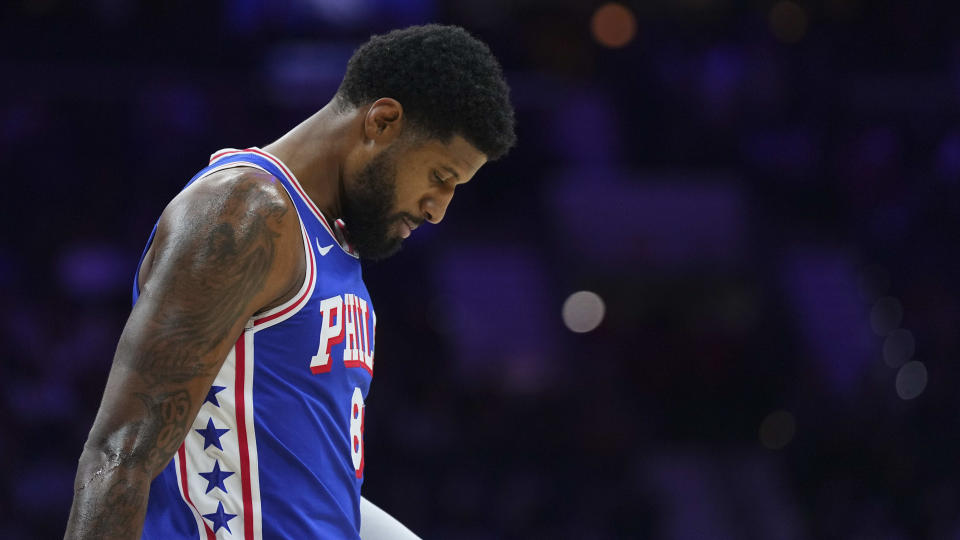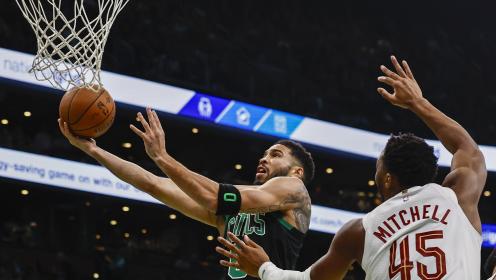
Each week during the 2024-25 NBA season, we will take a deeper dive into some of the league’s biggest storylines in an attempt to determine whether trends are based more in fact or fiction moving forward.
[Last week: The NBA needs more 3-point specialists]
Fact or Fiction: The NBA’s 2024 free-agency class was a dud
No team spent more on salary this past summer than the Philadelphia 76ers, who own the NBA’s worst record through the season’s first month — indirect evidence that the 2024 free-agency class was a bust.
Let us dive deeper into that question to see if teams managed to salvage some value.
First a reintroduction to Cost Per Win (CPW), a statistic created here in 2016 to measure the cost of each player’s contributions to a team’s success in a given season: We take the average annual value (AAV) of a player’s contract, divide it by that player’s win shares (WS) and extrapolate the data out to a full season. This provides us with an estimated account of how much teams are paying their players for each victory.
We separated the 56 free agents who changed teams over the summer into four categories: big-ticket ($12,859,001+), mid-tier ($5,183,000-$12,859,000), low-cost ($1,157,153-$5,182,999) and two-way players. It is harder to equate value across tiers. Teams expect to pay more per win for max-salaried players. Usage varies. Roles are different. Minimum-salaried players do not stabilize organizations. In fact, the addition of a high-priced free agent has been known to attract lower-cost ones, as was the case in Philadelphia.
2024 big-ticket NBA free agents
|
PLAYER |
AAV |
WS |
CPW |
|
1. DeMar DeRozan, SAC |
$24,630,000 |
1.5 |
$3,003,659 |
|
2. Klay Thompson, DAL |
$16,666,667 |
0.7 |
$4,355,401 |
|
3. Tobias Harris, DET |
$26,000,000 |
1.1 |
$4,900,222 |
|
4. Kentavious Caldwell-Pope, ORL |
$22,000,000 |
0.7 |
$6,132,404 |
|
5. Isaiah Hartenstein, OKC |
$29,000,000 |
0.1 |
$56,585,366 |
|
6. Paul George, PHI |
$52,896,235 |
0.1 |
$90,310,645 |
Eighty-eight players have registered at least a single win share through the season’s first month, and just two of them — Sacramento Kings standout DeMar DeRozan and Detroit Pistons forward Tobias Harris — were big-ticket acquisitions in free agency.
And who else was bidding for DeRozan or Harris?
Granted, Isaiah Hartenstein made his season debut for the Oklahoma City Thunder on Wednesday, the same day Paul George hyperextended his left knee for the second time in five weeks. We should expect then that Harris has made a greater impact on the Pistons than George has on the Philadelphia 76ers, though that is no less disheartening for the Sixers fans who rode Harris out of town.
Pause to consider how concerning the signing of George — the most skilled player in a shallow pool of big-ticket free agents — could be for Philly. He is the only player still active from the 2010 draft class, and he has played more than 56 games once in the past five years, his contract season. He has had major injuries to every one of his extremities, and will be paid $56.6 million in 2028, when he turns 38 years old.
It does not help that maximum-salaried teammates Joel Embiid and Tyrese Maxey cannot stay on the court, either. At some point the three of them will play sustained minutes together. Presumably they will win games. But it bears repeating: The 76ers have so far paid George $9 million to contribute one-tenth of a win share.
2024 mid-tier NBA free agents
|
PLAYER |
AAV |
WS |
CPW |
|
1. Kris Dunn, LAC |
$5,426,400 |
1 |
$1,058,810 |
|
2. Chris Paul, SAS |
$10,460,000 |
1.7 |
$1,200,574 |
|
3. Buddy Hield, GSW |
$9,439,024 |
1.2 |
$1,342,951 |
|
4. Naji Marshall, DAL |
$9,000,000 |
1 |
$1,646,341 |
|
5. Malik Beasley, DET |
$6,000,000 |
0.7 |
$1,777,003 |
|
6. Jonas Valanciunas, WAS |
$10,098,333 |
0.8 |
$2,001,194 |
|
7. Derrick Jones Jr., LAC |
$10,000,000 |
0.9 |
$2,168,022 |
|
8. Jalen Smith, CHI |
$9,000,000 |
0.4 |
$4,390,244 |
|
9. Caleb Martin, MIA |
$8,760,176 |
0.3 |
$4,985,466 |
|
10. De’Anthony Melton, GSW |
$12,822,000 |
0.3 |
$7,297,073 |
Four of those aforementioned 88 players received mid-tier contracts this past summer.
We also had 88 games of film on Kris Dunn in Utah, where he was his usual All-Defensive-caliber self and added a 3-point shot (40% on 147 attempts). Imagine not lining up for those services on short money. Yet the L.A. Clippers landed him on July 1 for the taxpayer’s midlevel exception. Pays to be early — and right.
Same goes for Naji Marshall, a hard-scrapping wing whose 3-point shooting spiked to a career-high 38.7% last season. That has dipped to 13% in this season’s early going, but the Dallas Mavericks should be encouraged that he is still generating significant value as they wait for his shot to progress to the mean.
Chris Paul, Buddy Hield, Malik Beasley, Jonas Valanciunas and Derrick Jones Jr. were known commodities when they entered free agency, and they are delivering on their promise for mid-tier salaries. They are all on pace for a handful of win shares this season, what Sixth Man of the Year Naz Reid provided for the Minnesota Timberwolves last season. In other words, $2 million a win is good value for a mid-tier salary.
2024 low-cost NBA free agents
|
PLAYER |
AAV |
WS |
CPW |
|
1. Jay Huff, MEM |
$2,527,660 |
1.1 |
$448,365 |
|
2. Tyus Jones, PHX |
$3,003,427 |
1.2 |
$488,362 |
|
3. Guerschon Yabusele, PHI |
$2,087,519 |
0.7 |
$509,151 |
|
4. Taurean Prince, MIL |
$2,988,550 |
0.7 |
$780,980 |
|
5. Cameron Payne, NYK |
$3,003,427 |
0.6 |
$915,679 |
|
6. Javonte Green, NOP |
$2,425,403 |
0.5 |
$946,499 |
|
7. Mason Plumlee, PHX |
$3,303,771 |
0.6 |
$1,074,397 |
|
8. Alec Burks, UTA |
$3,303,771 |
0.4 |
$1,309,421 |
|
9. Jordan McLaughlin, SAC |
$2,425,403 |
0.3 |
$1,478,904 |
|
10. Monte Morris, PHX |
$2,800,834 |
0.3 |
$1,821,681 |
The Memphis Grizzlies signed Jay Huff to a two-way contract in July, and a week into this season they upgraded him to a fully guaranteed salary for the next two years. He has more than earned that deal.
We should not be surprised that Tyus Jones appears on this list. His minimum salary was a gift to the Phoenix Suns, as he prioritized a considerable role to showcase his real value for the summer of 2025.
And, hey, at least the Sixers found some value on this salary tier, landing Guerschon Yabusele, whose value was evident to anyone who watched him perform against Team USA at the Olympics in Paris.
It is hard to make a grave mistake at this level of compensation. Unfortunately, the Sixers also have Eric Gordon and his -0.2 win shares.
But we should go back to the Clippers, whose first order of business in free agency was to sign Kevin Porter Jr. to a minimum contract. His -0.3 win shares are the fewest of anyone who has played as many minutes as he has (275). The Clippers are paying Porter to make their team worse, and that is nothing any team wants, especially from this player.
How could the Clippers be so accurate in their assessment of one player and so mistaken on another? Makes you wonder how much luck plays a part in the single-season success of minimum-paid players. Adding Jones at that salary is a no-brainer. But you do not know what you are going to get year-to-year from guys like Taurean Prince, Cameron Payne, Javonte Green and Mason Plumlee. Hope for their best.
2024 two-way NBA free agents
|
PLAYER |
AAV |
WS |
CPW |
|
1. Moussa Diabate, CHA |
$578,577 |
0.7 |
$151,196 |
|
2. Jamal Cain, NOP |
$578,577 |
0.2 |
$564,465 |
|
3. TyTy Washington, PHX |
$578,577 |
0.1 |
$1,128,931 |
|
4. JT Thor, CLE |
$578,577 |
0.1 |
$1,199,489 |
Which brings us to the two-way crew. Any contributions at that tier are valuable.
A second to praise Moussa Diabaté. The Clippers — yes, those same Clippers — declined his $2.1 million qualifying offer, making an athletic 6-foot-11 rim protector a free agent. No one offered the minimum. The Charlotte Hornets took a two-way flier, and he is owning his 16 minutes a night. He is efficient in his limited offensive possessions, rebounds like wild (16.3 per 36 minutes) and holds opponents in check.
Overall, the big-ticket free agents were a dud, the mid-tier free agents are middling, and the real value was among the low-cost free agents. And even then there are few difference-makers. The question is not whether the 2024 free-agency class was a dud but if free agency itself is dying as a team-building tool.
Determination: Fact. The NBA’s 2024 free-agency class was a dud.

